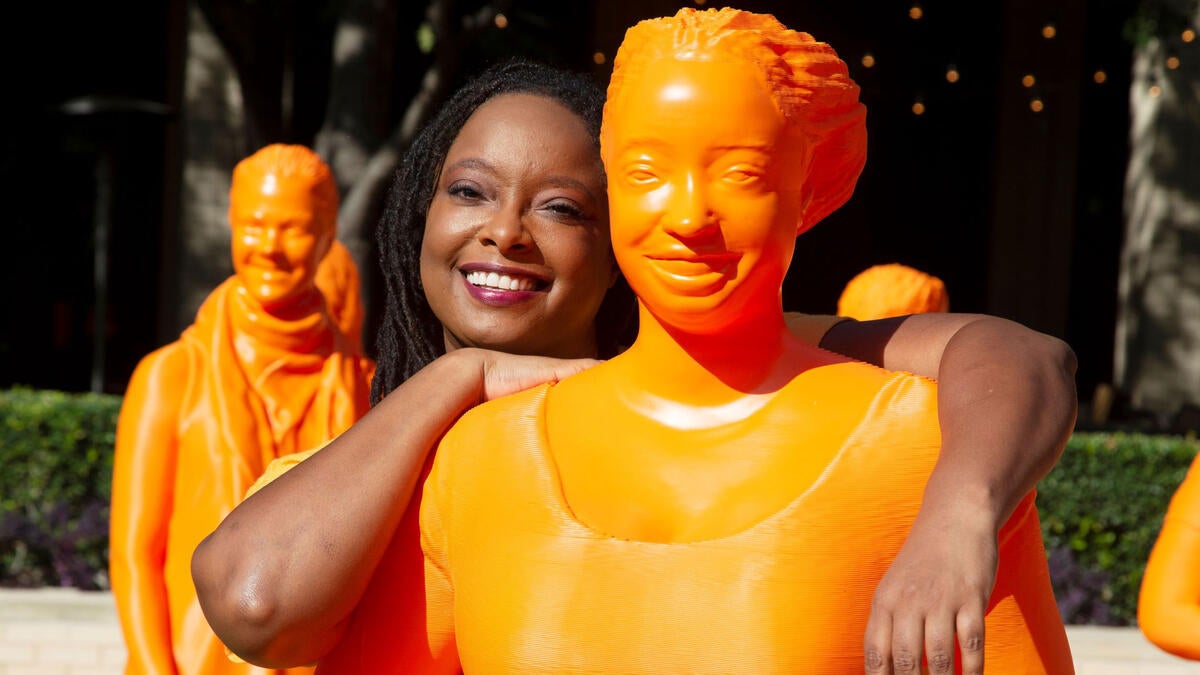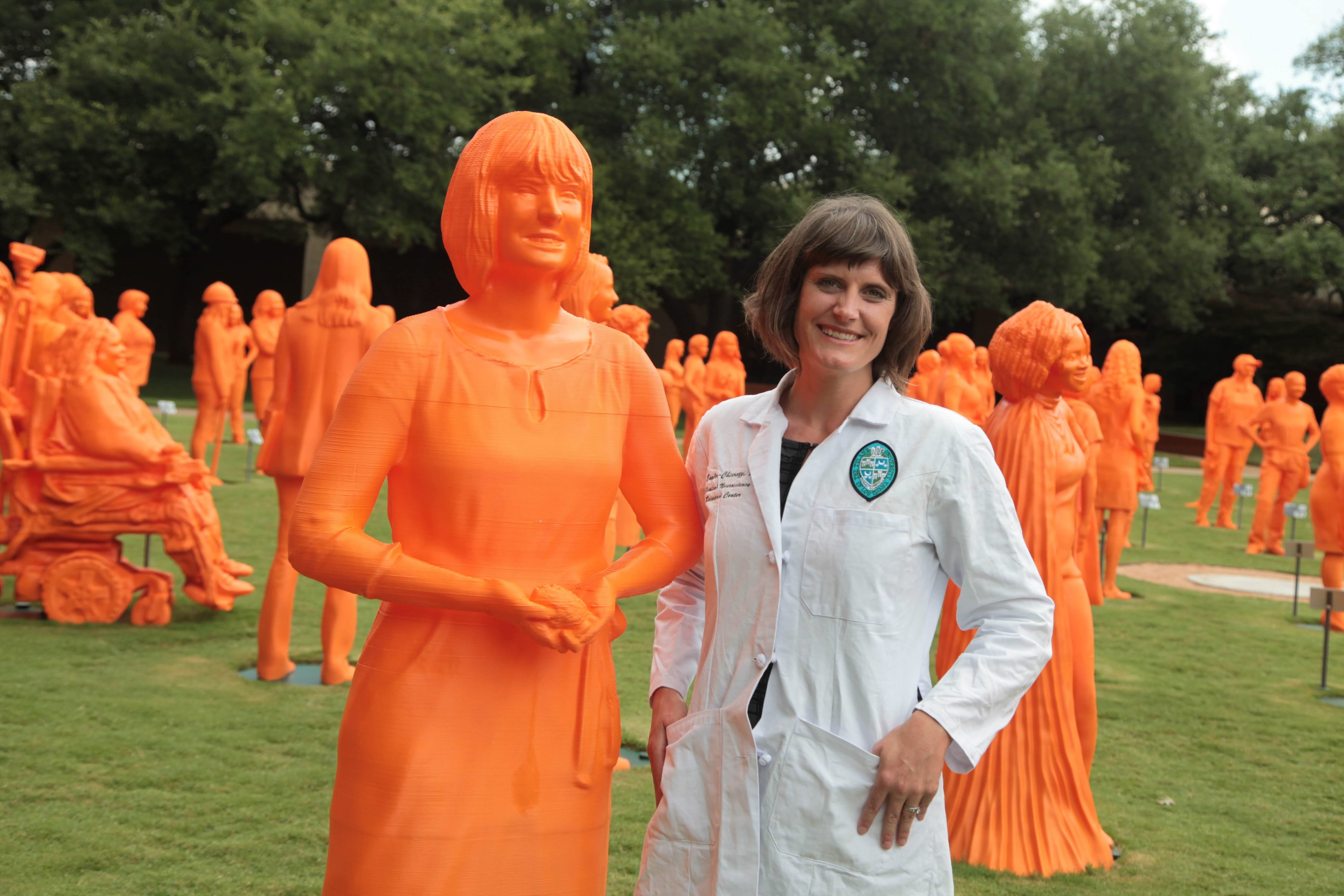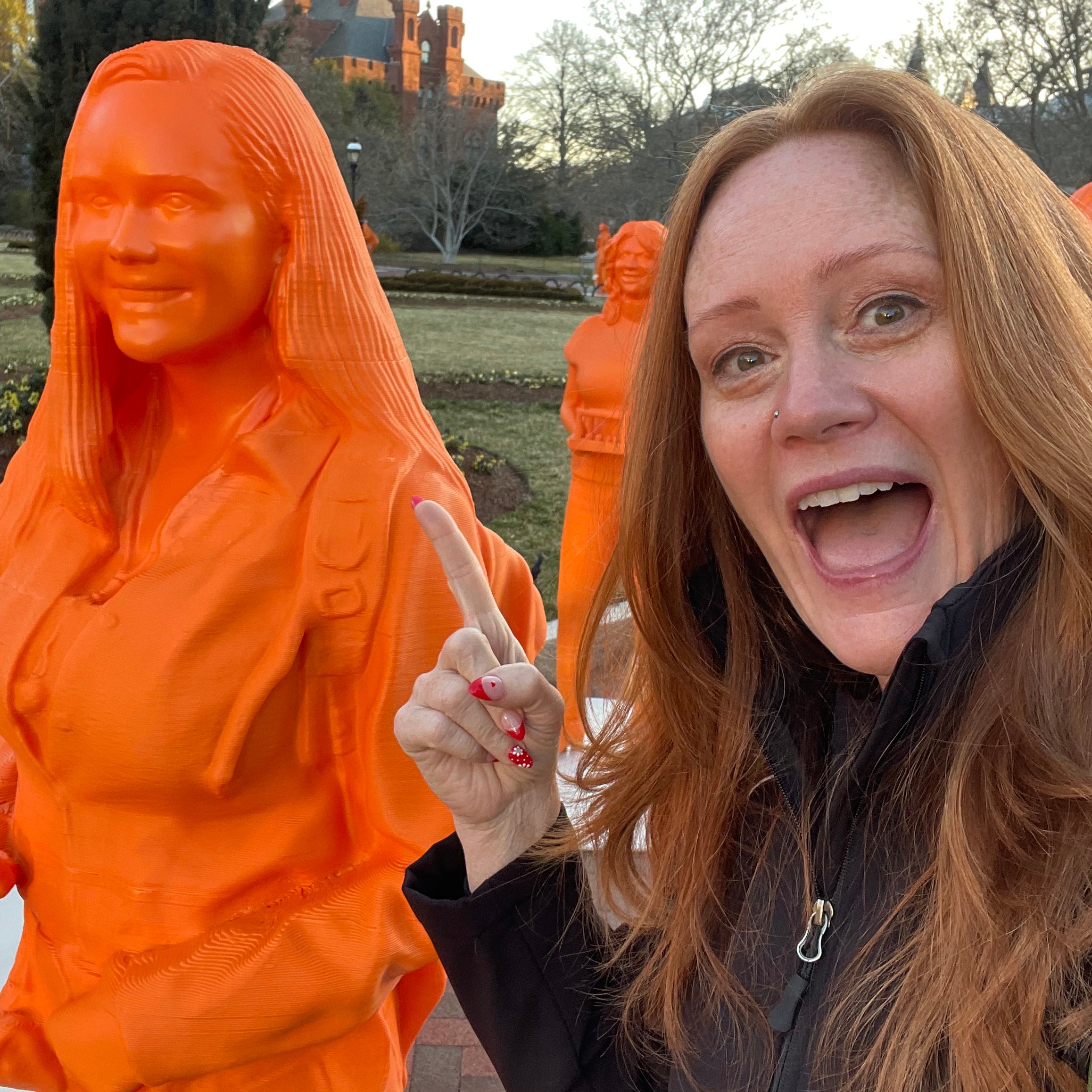Editor's note: An additional alumna came to light after this story originally published. The story has been updated to include Wendy Bohon.
Three Arizona State University women are immortalized in statue form on the National Mall in Washington, D.C., this month to highlight women in science, technology, engineering and math fields.
The statue exhibit features Lekelia Jenkins (pictured above with her statue), an associate professor in the School for the Future of Innovation in Society; Wendy Bohon, a geologist and science communications specialist who earned her PhD in 2014, and Elizabeth Engler-Chiurazzi, a neuroscientist who earned a bachelor’s degree in 2007 and a PhD in 2013, both in psychology at ASU.
The women are each represented as one of the 120 3D-printed statues in the “IfThenSheCan” exhibit in Washington, D.C., as part of Women’s History Month. The title refers to the motto, “If she can see it, then she can be it.” The statues will be displayed in the Smithsonian Gardens and in several Smithsonian museums through March 27.
The women were chosen by Lyda Hill Philanthropies and the American Association for the Advancement of Science. The honor is part of the IF/THEN ambassadorship bestowed on scientists who are active in community outreach.
Jenkins is a pioneer in the relatively new field of marine conservation technology.
“I grew up in Baltimore, and my family went fishing all the time. Crabbing was my favorite activity,” she said.
“During the summer, I was a junior zookeeper and I loved animals, and I knew I wanted to have an impact in wildlife conservation.
“I was interested in people and human systems.”
She earned her PhD at Duke University, which she said was open to the idea of mixing social science and natural science.
“Once I got there, it all clicked — of course I should be doing marine conservation,” said Jenkins, who also is a senior global futures scientist in the Julie Ann Wrigley Global Futures Laboratory at ASU.
“Water was such an important part of my life, and there are so many issues and not enough people to do the work.”
One area that Jenkins focuses on is sustainable fisheries.
“I’m now wrapping up a project looking at how to reduce waste in the seafood supply chain — actual animal life, but also water and fuel used to capture, produce and ship fish to the U.S. market,” she said.
She just received funding for a project looking at modern-day slavery and human abuses in fisheries and how electronic monitoring might be used to fight it.
Bohon works as a science communications specialist forIncorporated Research Institutions for Seismology in Washington, D.C. That organization maintains all the the seismaic data and instrumentation on behalf of the National Science Foundation around the world and on the moon and Mars.
At ASU, she researched earthquake geology.
"I was working with Ramon Arrowsmith and Kip Hodges and worked primarly on a fault system in India," she said. "I also did work on the San Andreas Fault. It was about understanding how fault systems move and how we can understand the land by seeing what happened in the past to see how it will happen in the future."
Elizabeth Engler-Chiurazzi, a neuroscientist who earned a bachelor’s degree in 2007 and a PhD in 2013, both in psychology at ASU, with the statue of her likeness.
Engler-Chiurazzi is an assistant professor in the neurosurgery department at Tulane University Brain Institute and the Tulane University Clinical Neuroscience Research Center.
“I got to ASU and took my first psychology course and a lightbulb went off. The content wasn’t easy, but it was enjoyable and fun to learn about,” she said.
“I got interested in the inner workings of the brain and focused within the biology side of psychology, but also interested in the behavioral readout of that biology.”
For her PhD, she researched how sex hormones such as estrogen affect the trajectory of brain and cognitive aging in women.
Now she researches how the nervous and immune systems work together.
“One project that I have a funded grant for looks at B lymphocytes, which are part of your immune system that secrete antibodies, among other functions. I’m looking at the role these cells have in modulating how we respond to psychological stressors. That's a new and emerging field,” she said.
“The other project is understanding how infection experiences across your life may impact the way your brain ages and the way you maintain your cognitive function.”
'I didn't see anyone like me'
Jenkins minored in dance as an undergraduate, and soon realized the potential of communicating about science that way.
“I’ve created dances about topics like sea turtle conservation,” she said.
“I began to study why this seems to have traction and helps people remember the conservation lessons we teach and want to explore.”
Jenkins believes that dance can help people grow empathy and retain information better.
“In our society, adults rarely have permission to move their bodies creatively in all the different ways a body can move,” she said.
“And we rarely have permission to touch someone who is not in our family or a friend and to be touched by someone.
“It’s one thing to talk about or watch something happening, but when you depict a sea turtle who is about to die or a person who rescues a sea turtle, it shifts something in our brains. It lasts.”
She does science dance in different ways, creating videos, producing shows and running workshops.
The COVID-19 pandemic shut down much of Jenkins’ dance work, but she hopes to resume it soon. In the meantime, she has pivoted to doing outreach through social media videos.
Jenkins, who is Black, realizes the importance of outreach to girls who haven’t seen anyone like them in STEM fields.
“I didn’t see anyone like me. I borrowed pieces of people and things,” she said.
“I loved reading all the biographies of wildlife veterinarians. They were all white men. And I admired Jane Goodall because she was a woman who was in Africa interacting with chimpanzees and caring about their conservation.”
She remembers the first time she saw a Black fishery scientist, Daniel Pauly, being interviewed at a conference.
“It was something out of a movie because he was surrounded by cameras,” she said.
“I had those moments, but largely I had to have confidence in myself.”
Bohon does a lot of outreach in her job, training scientists how to communicate their work and talking to several classrooms of kids every week.
"I’ve always been in that space of trying to be the translator between the academic community and the policymakers and people who use the data we produce," she said.
She's also very involved in the organzation 500 Women Scientists, which is working to make science more inclusive to women and minorities.
"500 Women Scientists is trying to expand the vision of what a scientist looks like, who can be a scientist and what it looks like to do science," she said.
Bohon used to work as an outreach and education coordinator for the U.S. Geological Service's Earthquake Hazards Program.
"The people in charge there were women, and I didn't realize at the time how profoundly that influenced me," she said.
"I got to grad school and I was like, 'Where are my ladies?' If you can see somone who looks like you doing a job, you can imagine youself doing a job."
Wendy Bohon, who earned a PhD at ASU in 2014 with her statue.
Engler-Chiurazzi said she first became inspired to do scientific outreach while an undergraduate working on her honors thesis with Heather Bimonte-Nelson, who was then a new faculty member at ASU and is now a President’s Professor in the behavioral neuroscience program in the Department of Psychology.
“I can’t mention any successes I’ve had or community outreach without pointing to my experiences with Dr. Bimonte-Nelson when I was undergraduate,” she said.
“It’s definitely shaped the course of my career and was an instrumental piece in being awarded the IF/THEN ambassadorship and being able to inspire people with the statues.”
Bimonte-Nelson started visiting classrooms to get kids excited about neuroscience and brought several students, including Engler-Chiurazzi, with her.
“I was raised by a single mom on welfare, and I always felt that through all the times we moved and all of the things throughout my childhood, the thing that stuck with me were the things I learned and my books,” Bimonte-Nelson said.
“Eventually, I learned that it was the way out of my own struggles, including my internal struggle. I recognized that it could be my way to have a life I dreamed about."
She started visiting schools, bringing microscopes and human brains, in a program that’s now called Brain Fair.
“But when it came time for questions, they didn’t want to hear about the science; they wanted to hear what college was like," she said. "I realized that I was lugging all this stuff there when the most impactful thing was to get them here at the university.”
Now, Brain Fair brings third, fourth and fifth graders to ASU to do activities, eat pizza and meet college students on campus. The sessions, shut down during the pandemic, will soon resume.
Those undergraduate outreach experiences had a huge impact on Engler-Chiurazzi.
“It really lit a fire for me in the necessity of educating the public about what we’re doing and paving the way for the next generation of scientists,” she said.
As a postdoc at West Virginia University, she partnered with the WVU Neuroscience Club to visit classrooms and bring enthusiastic undergraduates who could serve as role models. They also set up a program known as Feed Our Brains, raising money to pay down student lunch debt.
“There were a number of needs in our community that were barriers to student learning. Food security was a big issue,” she said.
In New Orleans, she’s launched the NOLA Books and Brains program, inspired by her daughter.
“We took her to a museum in New York and she saw an exhibit about space and got very engaged. As soon as we got back from the trip, she went to the school library and asked for more books about space. So I was thinking about leveraging the library system in a way that would support neuroscience engagement. We looked into this, and it turns out that, by and large, neuroscience books for children are not available,” she said.
So she used her mini-grant from the IF/THEN fellowship to buy neuroscience books for kids, donating them to brick-and-mortar libraries as well as to free little libraries.
Creating a likeness
To create the statues, each woman stood in a circular room while multiple cameras took photos of them from every angle. The images were stitched together with software and the life-sized representations were created on a 3D printer.
The statues were ready for display in spring 2020, but the pandemic forced the cancellation of the unveiling event. They were displayed last year in Dallas.
Because she lives in Washington, D.C., Bohon has been to see her statue several times.
"Every time I go I intend to just show the statue to somebody and I end up staying two hours," she said.
Earlier this month, she was standing by her statue wearing combat boots, a leather jacket and a beanie, and a girl on a school trip said, "You don't look like a scientist."
"I was like, 'This is it. This is not a drill.' (The girl) said, 'You have a nose ring.' And I said, 'Yes. Also a scientist.'"
All three of the women have taken their families to see the exhibit.
“With the sheer size of the display — the great number of women depicted that took up a ton of space — there can be no doubt that women are represented in the field of STEM. There were so many to learn about and be inspired by,” said Engler-Chiurazzi, who thought “they nailed it” with her likeness, which is now displayed at the Smithsonian Castle.
“My daughter came with me, and there’s a great picture of her hugging the statue, and it had a meaningful impact on her, and that’s what this is all about — the 8-year-olds who are just figuring themselves out,” she said.
Jenkins thinks the nose on her statue is a little bit off, but she was very moved when she found out that her likeness would displayed at the National Museum of Natural History this month.
“I thought, ‘I could come to this museum every day of my life and still not learn everything,’” she said.
“To be connected to that museum is so meaningful to me.”
More Science and technology

Indigenous geneticists build unprecedented research community at ASU
When Krystal Tsosie (Diné) was an undergraduate at Arizona State University, there were no Indigenous faculty she could look to in any science department. In 2022, after getting her PhD in genomics…

Pioneering professor of cultural evolution pens essays for leading academic journals
When Robert Boyd wrote his 1985 book “Culture and the Evolutionary Process,” cultural evolution was not considered a true scientific topic. But over the past half-century, human culture and cultural…

Lucy's lasting legacy: Donald Johanson reflects on the discovery of a lifetime
Fifty years ago, in the dusty hills of Hadar, Ethiopia, a young paleoanthropologist, Donald Johanson, discovered what would become one of the most famous fossil skeletons of our lifetime — the 3.2…


